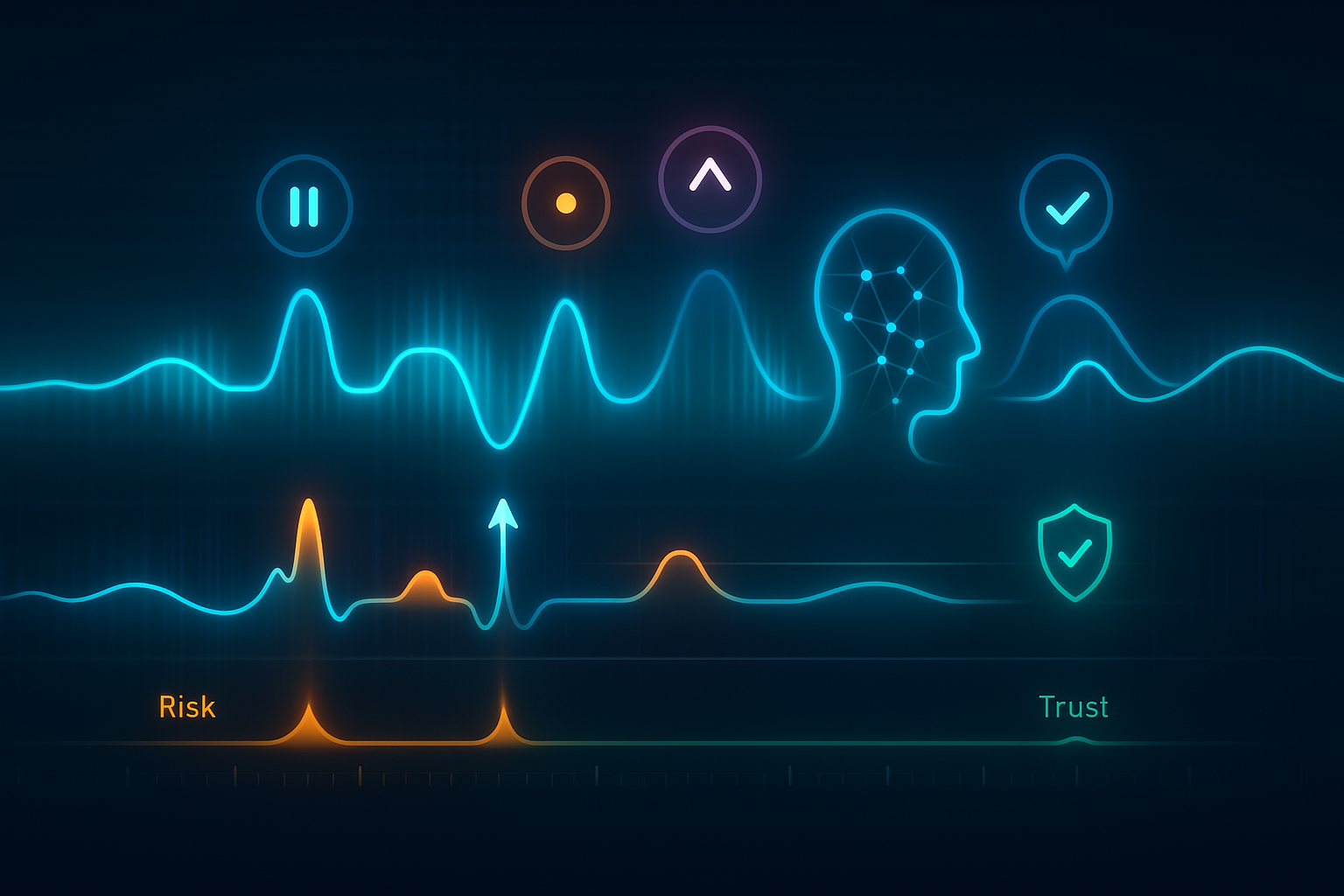Speech Disfluencies as Truth Signals: Pauses, Hesitations, Risk

In the world of customer interactions, what isn't said often matters more than what is. Those awkward pauses, unexpected "ums," and subtle hesitations that punctuate our conversations aren't just linguistic hiccups—they're valuable truth signals that can transform how businesses understand their customers, detect risks, and optimize experiences. Welcome to the emerging field of speech analytics hesitation detection, where artificial intelligence meets human psychology to unlock insights hidden in plain sight.
The Science Behind Speech Disfluencies
Speech disfluencies encompass the natural interruptions in our verbal communication: prolonged pauses, filler words like "uh" and "um," word repetitions, and false starts. While traditional communication analysis focused solely on content, modern voice analytics technology recognizes these seemingly imperfect elements as rich sources of behavioral intelligence.
Research in psycholinguistics has consistently shown that disfluencies correlate with cognitive load, emotional state, and decision-making processes. When someone hesitates before answering a question about their income during a loan application, that pause might signal more than just careful consideration—it could indicate uncertainty, discomfort, or even intentional deception.
This understanding has profound implications for customer conversation analysis, where businesses can leverage these subtle cues to make more informed decisions about risk, service delivery, and relationship management.
Why Hesitation Detection Matters in Modern Business
Financial Services: The First Line of Defense
In banking and insurance, fraud detection through speech patterns has become increasingly sophisticated. A customer who exhibits unusual hesitation patterns when discussing transaction details or claim circumstances may warrant additional scrutiny. This isn't about presuming guilt, but rather about identifying risk indicators that human agents might miss during high-volume interactions.
Consider a scenario where a customer calls to report a stolen credit card. Natural speech flow when describing the discovery would differ significantly from the hesitation patterns of someone fabricating details. AI-powered speech analysis can flag these discrepancies in real-time, allowing fraud prevention teams to focus their attention more effectively.
Healthcare: Understanding Patient Communication
Healthcare providers increasingly rely on conversational AI insights to improve patient interactions. When patients hesitate while describing symptoms or medical history, it often indicates areas of concern, confusion, or discomfort that require additional attention from healthcare professionals.
This application of speech disfluency analysis extends beyond clinical conversations to insurance verification calls, telemedicine consultations, and patient satisfaction surveys, providing healthcare organizations with deeper understanding of patient needs and concerns.
Retail and Customer Service: Enhancing Experience Through Understanding
In customer service environments, real-time voice insights about hesitation patterns can dramatically improve interaction outcomes. When customers pause before agreeing to a service upgrade or hesitate when asked about their satisfaction, these signals provide valuable feedback that goes beyond traditional survey responses.
Smart customer service platforms now incorporate speech pattern recognition to guide agents toward more empathetic responses, helping them recognize when to slow down, provide additional clarification, or adjust their approach based on the customer's verbal cues.
The Technology Behind Speech Analytics Hesitation Detection
Modern speech analytics hesitation detection systems combine several advanced technologies to achieve accurate results:
Acoustic Analysis and NLP Integration
The foundation lies in sophisticated acoustic analysis that measures pause duration, identifies filler words, and tracks changes in speech rhythm and intonation. This acoustic data is then processed through natural language processing algorithms that understand context, ensuring that technical delays or natural speaking patterns aren't misinterpreted as deceptive signals.
Machine Learning for Pattern Recognition
AI-powered speech analysis platforms use machine learning models trained on vast datasets of human conversations to identify meaningful hesitation patterns. These models learn to distinguish between cultural speech variations, technical difficulties, and genuinely significant disfluencies that warrant attention.
Real-Time Processing Capabilities
The most valuable voice analytics technology implementations provide real-time analysis, offering immediate insights that can influence ongoing conversations. This real-time capability enables proactive responses rather than reactive analysis after calls have concluded.
Business Applications and ROI Impact
Risk Management and Compliance
Organizations implementing customer conversation analysis for risk management report significant improvements in fraud detection accuracy while reducing false positives that can damage customer relationships. By combining traditional verification methods with speech pattern recognition, financial institutions create more robust risk assessment frameworks.
Customer Experience Optimization
Conversational AI insights derived from hesitation analysis enable more personalized customer experiences. When systems detect uncertainty or confusion in customer responses, they can automatically prompt agents to provide additional clarification or offer alternative solutions.
Sales and Revenue Enhancement
In sales environments, understanding when prospects hesitate allows for more nuanced approaches to objection handling and relationship building. Real-time voice insights about customer uncertainty can guide sales representatives toward more effective closing techniques or identify when additional information is needed.
Quality Assurance and Training
Speech disfluency analysis provides unprecedented insights for agent training and quality assurance programs. By identifying patterns in how customers respond to different approaches, organizations can develop more effective training protocols and coaching strategies.
Ethical Considerations and Implementation Best Practices
Privacy and Transparency
Successful implementation of AI-powered speech analysis requires transparent communication with customers about voice data collection and analysis. Organizations must ensure compliance with regulations like GDPR, HIPAA, and industry-specific privacy requirements while maintaining customer trust.
Cultural Sensitivity and Bias Prevention
Voice analytics technology must account for cultural differences in communication styles and speech patterns. What might seem like suspicious hesitation in one cultural context could be perfectly normal conversational behavior in another.
Human Oversight and Judgment
While speech analytics hesitation detection provides valuable insights, it should augment rather than replace human judgment. The most effective implementations combine AI-powered analysis with human expertise to ensure appropriate responses to identified patterns.
Future Developments in Speech Analytics
Enhanced Context Awareness
Next-generation conversational AI insights platforms will incorporate broader contextual understanding, considering factors like conversation history, customer profiles, and situational variables to provide more accurate interpretations of speech patterns.
Predictive Analytics Integration
Future customer conversation analysis systems will move beyond real-time detection to predictive modeling, identifying customers likely to exhibit certain behavioral patterns based on historical speech analysis data.
Multi-Modal Analysis
Advanced voice analytics technology will integrate speech pattern analysis with other communication channels, providing comprehensive insights across phone, video, and digital interactions.
Conclusion: Listening Between the Lines
Speech analytics hesitation detection represents a fundamental shift in how businesses understand and respond to customer communications. By recognizing that every pause, hesitation, and verbal stumble carries meaning, organizations can create more empathetic customer experiences, improve risk management, and build stronger relationships based on deeper understanding.
The key to success lies in implementing these technologies thoughtfully, with appropriate human oversight and ethical considerations at the forefront. As AI-powered speech analysis continues to evolve, businesses that master the art of listening between the lines will gain significant competitive advantages in customer understanding and relationship management.
In our increasingly digital world, the human elements of communication—including our imperfections and hesitations—remain powerful sources of insight. The organizations that learn to hear these subtle truth signals will be better positioned to serve their customers, manage risks, and build lasting business success.







